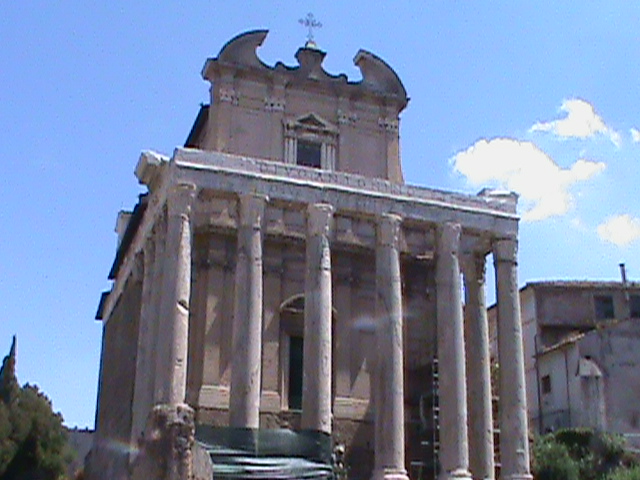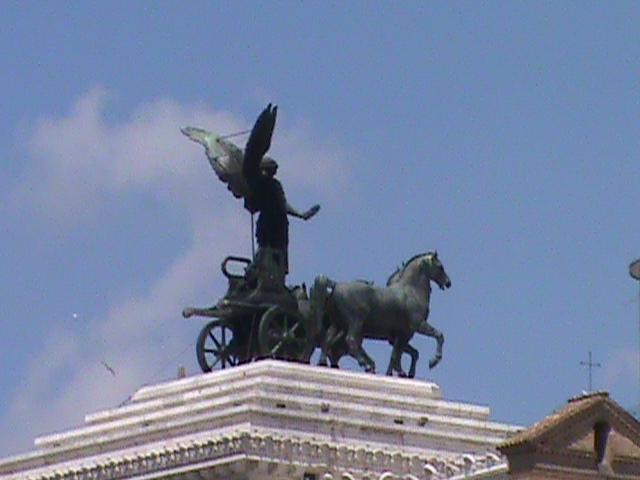Today in Rome, the Forum is a set of ruins next to the Colosseum. This particular forum is the oldest of Rome's various forums. It was originally an Etruscan cemetery dating from the 7th century BC. During the height of Rome's popularity, this was a busy place.
Around the 4th century, the area started to lose its importance, and by the Middle Ages it was a cow field. The Romans themselves plundered the area for stone, marble, and various pieces of artwork to decorate their homes, churches and palaces. The Vatican has an extensive collection of plundered material!
During the Renaissance a new appreciation for all things classical emerged. The area around and in the Forum was excavated in the 18th and 19th centuries, and archeologists are still at work today.
So let's look at the pictures while I describe them:
Before entering the forum with my group we were surprised by a group of Peruvians celebrating Inti Raymi - the Incan Summer Solstice celebration! Having seen this in Peru, I ended up explaining it to our guide and group members.
I am not sure what was going on here other than these were mystics of some sort. The man in orange sitting on the ground is hold a pole with a platform on which another man is sitting. My sister tells me they are street performers. The Forum is a fascinating place.
And for fun and tourist money, we have men dressed in gladiator costumes who will take a picture with you for 5 euros. I should have broken down and done it! Every now and then it is okay to do
something cheesy!
The next seven pictures are of the "big picture" of how the Forum looks in modern Rome.
The Vestal Virgins were a college of priestesses who honored the goddess Vesta, keeper of home and hearth. These priestesses had a variety of duties not allowed to be completed by male counterparts. Romans thought that the well-being of the empire was in the hands of these women. Vestals had the power to stop an execution if appealed to.
There were usually no more than six Vestals at one time. They were chosen at anytime from the ages of 6- 10 years and usually from patrician families. They were under contract to keep their virginity for 30 years. Once the thirty years was up, the Vestal was married to a patrician man if she so chose. The Vestals had a paid salary, and a retirement pension! It was considered good luck to marry a retired vestal.
Should a Vestal lose her virginity (give it away! Because it is just not something one can misplace.), she would be buried alive as her blood was not to be spilled. The man in the crime would be flogged to death.
This is what is left of the Vestal complex:
 |
| This is the palace of the Emperor Domitian in the Palentine - ancient Rome's version Palm Beach. This palace overlooks the Vestal complex -I wonder why! |
 |
| What is left of the Vestals Temple |
The ancient Romans worshipped a pantheon of gods and goddesses. They basically borrowed the Greek gods, and gave them new names - except Apollo - he has the same name in both Greek and Roman mythology.
Here are a few of the temples/churches, with a few arches thrown in:
(Despite my efforts, trying to get these pictures in the order I wanted them in was a futile effort.)
 |
| The Temple of Saturn was always used as the public treasury. It was also a repository for the decrees of the Senate. An underground chamber held sacred treasures. |
O
 |
| The three remaining columns of the Temple of Castor and Pollux |
 |
| Arch of Septimius Severus, a military commander who ruled from A.D. 193 - 211 |
 |
| Detail of the Temple of Antonino and Faustina. Their names are visible. |
 |
| The Basilica Fulvia Aemilia, built in 179 B.C., it was a shopping mall! It was later turned into a church. |
 |
| The entrance to the Basilica Fulvia Aemilia. The columns of purple granite come from Egypt. |
 |
| An original Roman fresco in the Basilica Fulvia Aemilia |
 |
| One of the original icons painted in the Basilica Fulvia Aemilia. |
 |
| Arch of Titus |
 |
| Detail was very important to the sculptors of ancient Rome |
 |
| A heart! |
 |
| Arch of Constantine |
There is much of the Forum that I did not get to see. I will be better prepared the next time I go.



















No comments:
Post a Comment